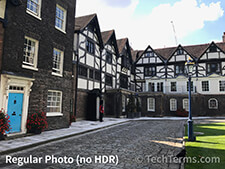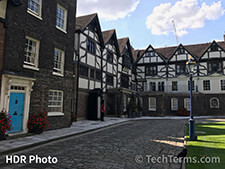HDR
Stands for "High Dynamic Range." HDR is a technology that improves the range of color and contrast in a digital image. It may be used for both photos and videos, though the implementations are different.
HDR Photography
An HDR photo is created by capturing multiple images with different exposures at the same time. Instead of taking a single photo, the camera captures three or more photos in quick sequence using different exposure values. For example, a digital camera might take one photo with a -1 exposure setting, one with the default (automatic) exposure, and one with a +1 exposure setting. The camera (or smartphone) then combines the photos to create a single image.
HDR image processing is useful when taking photos of scenes with high contrast. For example, if you are standing in front of window during a sunny day, the backlight might cause the automatic exposure to be too low, making your face appear dark. If you adjust the exposure to brighten your face, the window will become too bright — possibly completely white. By combining multiple exposures, these levels can be averaged out, allowing your face to be visible in the photo while not overexposing the light behind you.
Many digital cameras and smartphones, such as the iPhone, have an HDR option. You can often choose from from three different HDR settings — OFF, ON, or Auto, which only takes an HDR photo in high-contrast situations. Most cameras will also capture a regular photo at the same time, so you can choose between the HDR or regular photo for each HDR image captured.
HDR Video
HDR video is captured in a similar way to an HDR photo. Each scene is recorded with different exposures (or different ISO settings) at the same time. These scenes are blended together to create a single recording. This typically results in a brighter video, though it can also create a grayish effect that may look unrealistic. For this reason, HDR recordings are often modified in post-production before being published.
In order to display HDR video correctly, the output device (such as a TV or computer monitor) must also support HDR. An HDR-capable TV, for example, must support certain video output standards. These include 10-bit color and at least 90% of the DCI-P3 color space, a range of RGB colors defined by the American film industry. An HDR display must also support specific HDR formats, such as HDR10, Dolby Vision, and Hybrid Log Gamma (HLG). Most HDR televisions support all of these standards and can be updated using firmware updates that can be downloaded from the Internet.
 Test Your Knowledge
Test Your Knowledge
